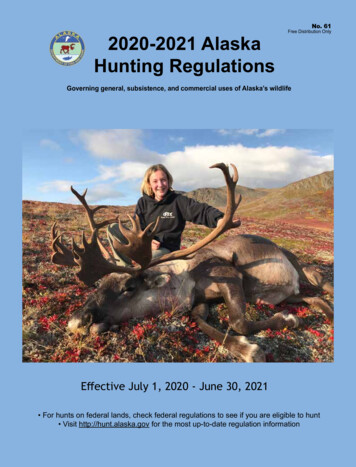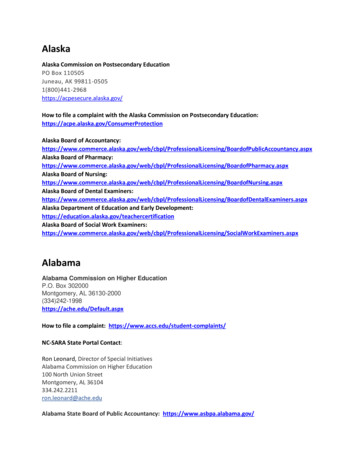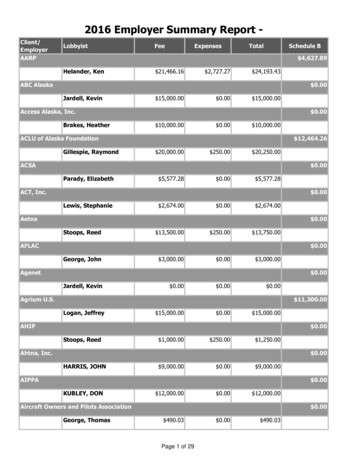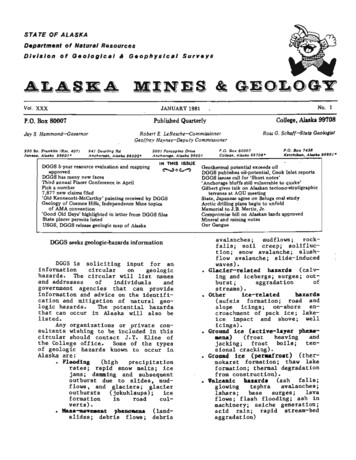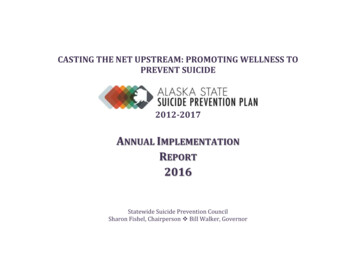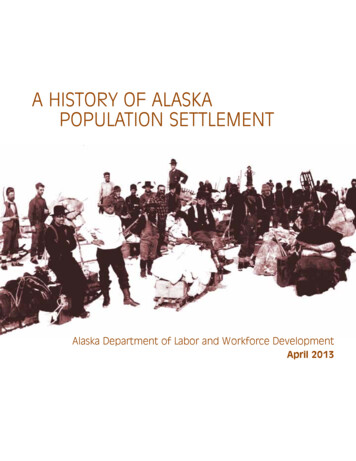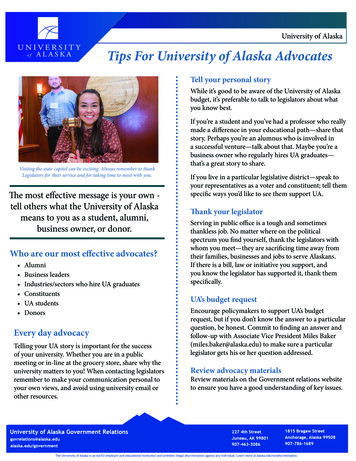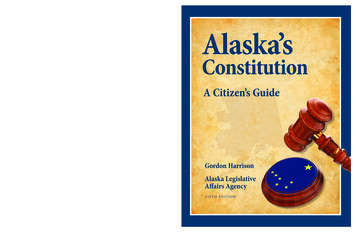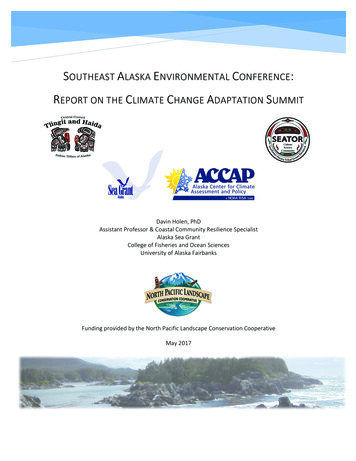
Transcription
SOUTHEAST ALASKA ENVIRONMENTAL CONFERENCE:REPORT ON THE CLIMATE CHANGE ADAPTATION SUMMITDavin Holen, PhDAssistant Professor & Coastal Community Resilience SpecialistAlaska Sea GrantCollege of Fisheries and Ocean SciencesUniversity of Alaska FairbanksFunding provided by the North Pacific Landscape Conservation CooperativeMay 2017
EXECUTIVE SUMMARYIn Southeast Alaska climate change impacts are unique and are longer-term impacts such as heavy rainscausing flooding, ocean acidification, warmer waters, snowfall variations, warm springs followed by frostaffecting wild berry production, invasive species, and toxins in the marine environment. These factorsimpact food security and access and abundance of culturally important resources. In September 2016,the Central Council of Tlingit and Haida Indian Tribes of Alaska, in collaboration with Southeast AlaskaTribal Ocean Research, held a two-day workshop in Ketchikan to review and plan monitoring, mitigation,and adaptation strategies to address climate change in their region. Alaska Sea Grant facilitated thediscussion of this workshop, which became called the Southeast Alaska Climate Adaptation Summit.There were 80 participants at the workshop; approximately 30 were from Federal and State agencies, theUniversity, as well as various Southeast Alaska non-profits. The remaining 50 participants wereenvironmental program managers and coordinators from 17 Tribes in Southeast Alaska. Funding from theNorth Pacific LCC provided travel funding and daily conference costs at the Cape Fox Lodge in Ketchikan.Researchers from the State of Alaska, federal agencies, the University of Alaska Southeast, and SoutheastAlaska non-profits provided information on the latest research on resources identified by SoutheastAlaska Tribes as culturally important; salmon, shellfish, berries, yellow cedar, as well as cultural sites andhuman health. Over two-days participants described their concerns related to these resources. Thisincluded concerns raised about changing ocean conditions including ocean acidification, warming water,harmful algae blooms, contamination of water sources, both marine and freshwater, changes in theterrestrial environment, and phenology. For example, residents note that warmer water in the marineenvironment at the outflow of streams is causing a disruption in the salmon migration patterns, whichmoving into the future will make it more difficult for fisheries managers to ensure adequate escapementand harvest timing.The outcome of the summit will be an effort to build greater collaboration and sharing of tools andinformation. Participants discussed activities to pursue as a group that involve community basedmonitoring such as marine and riverine water monitoring program. Water monitoring would establish along-term program to document stream temperature and flow, marine temperature and salinity, andsnow depth and rain volume. This includes building a collaboration between agencies, the University,local non-profits, and Tribal environmental programs. In addition, organizers of the summit recognizedthat a central repository was needed to provide communities with basic information on climate change2
and resulting impacts in Alaska, a method of sharing stories of successes, and tools for planningmonitoring, mitigation, and adaptation activities as an outcome of this project. To bring togetherinformation about community resilience and adaptation in Alaska a website called Adapt Alaska is beingdeveloped. Besides having unique content the website will act as a portal to other relevant sites that arespecific to Alaska. Additional funding for the website has been provided by the Aleutian Bering Sea IslandsAssociation, and the Aleutian Pribliof Islands LCC. Alaska Sea Grant will host and manage the website toprovide long-term stability and will incorporate existing relevant Alaska Sea Grant web materials onclimate change and coastal hazards.Finally, Central Council has received funding from the Bureau ofIndian Affairs to draft a region-wide climate adaptation plan. The plan is currently in development andwill incorporate information that was learned as part of this summit and take advantage of theinformation being compiled for the Adapt Alaska website.3
INTRODUCTIONClimate change is a complex global phenomenon offering an uncertain future that is difficult tocommunicate to local audiences. There are too many competing factors: physical forces, politics,economic, and cultural barriers (Ballantyne 2016:10). Lost in this discourse is clarity in the message tonorthern communities of the state of the science and how local observations are taken into considerationin the verification of climate impacts at the local level. It has become difficult for local people tounderstand what are actual effects of climate change, what is global warming, and what are weather andclimate variability (Moser 2010:33; Weber 2016:4). In Southeast Alaska climate change impacts areunique and are longer term impacts such as heavy rains causing flooding, ocean acidification, warmerwaters, snowfall variations, warm springs followed by frost affecting wild berry production, invasivespecies, and toxins in the marine environment. These factors impact food security and access andabundance of culturally important resources.In early December 2015, the Central Council of Tlingit and Haida Indian Tribes of Alaska (CCTH) andSoutheast Alaska Tribal Ocean Research (SEATOR) at the Sitka Tribe of Alaska in collaboration with theSwinomish and Tulalip Tribes of Washington, the US Forest Service, and others held a climate changeadaptation workshop in Tulalip Washington for Southeast Alaska Tribes.Tribes from the regiondiscussed climate stressors and prioritized their concerns of the impacts of climate change. Even inSoutheast Alaska climate change impacts differ regionally such as storm surges eroding the coastline inYakutat, to Wrangell where ocean acidification may be the most drastic impact to the local economy andway of life (Frisch, et al. 2015; Mathis, et al. 2015). In some parts of Southeast Alaska residents areobserving an important cultural resource, yellow cedar, slowly start to disappear. Cedar is used inbentwood boxes and Chilkat blankets as well as other cultural elaborations that are important for Tlingitand Haida identity.The outcome of the climate change workshop was one of the most significant concerns of Southeastresidents was potential climate change impacts to resources important for subsistence practices andcultural elaboration.Recent studies have documented the harvest and use of wild resources bySoutheast Alaska residents (Holen, et al. 2014; Sill and Koster 2017). Participants in these studies havevoiced concerns over changes in their areas due to climate change.4
To address the concerns of Tribes in Southeast Alaska, CCTH in collaboration with SEATOR and theirplanning team added two days to the annual Southeast Alaska Environmental Conference in September2016 to discussing climate adaptation planning. Alaska Sea Grant facilitated the discussion of thisworkshop, which became called the Southeast Alaska Climate Adaptation Summit. As a result of theworkshop in Washington the group chose to focus on a few key resources; salmon, shellfish, berries,yellow cedar, as well as cultural sites and human health.METHODSThis workshop was held in Ketchikan on September 21-22, 2016. There were 80 participants at theworkshop; approximately 30 were from Federal and State agencies, the University, as well as variousSoutheast Alaska non-profits (see Appendix 1 for schedule). The remaining 50 participants wereenvironmental program managers and coordinators from 17 Tribes in Southeast Alaska. The workshop isa partnership with CCTH and SEATOR.Funding from the North Pacific Landscape ConservationCooperative (LCC) provided travel funding and daily conference costs at the Cape Fox Lodge in Ketchikan.Researchers from the State of Alaska, Federal agencies, the University of Alaska Southeast, and SoutheastAlaska non-profits provided information on the latest research on resources noted above identified bySoutheast Alaska Tribes as culturally important. The first day was dedicated to discussing the latestmonitoring activities for these important cultural resources. This was followed at the end of the day bysmall group discussions; 6 groups of approximately 10-12 participants. A summary of discussion groups isprovided below. Moderators were given a list of questions including which communities are representedin the group and what is the current issues related to climate change in your community. This wasfollowed by a brainstorming session to get groups to think about immediate things they could do toaddress the second question and then a follow-up question to get them to think about planning for futureresearch with funding. The questions were based on the second question; if given no new funding, whatmonitoring, mitigation, or adaptation projects could your Tribe undertake, and with outside assistance,which includes technical assistance and a small amount of funding, what one project would you want toundertake as part of the Tribe’s Environmental Program. Answers to each question were recorded by themoderators as well as a general outcome for each group. Groups then provided a synthesis to the largerworkshop. On the second day, additional monitoring activities were discussed through presentations byUniversity, State, Federal, and regional non-profits. At the end of the second day a summary wasprovided and plans and partnerships were discussed.5
SOUTHEAST ALASKA CLIMATE CHANGE ADAPTATION SUMMITThe following is a summary of the group discussions. Responses could be broken down by issues havingto do with water, changes in the landscape, and phenology, or climatic conditions impacting seasonalityof resources. Although the focus of the workshop was on salmon, shellfish, the forest environment, andcultural sites, respondents did not limit their discussion to these resources. It should also be noted thatearlier in the week water quality was a bit topic due to discussions between tribes and the EnvironmentalProtection Agency on fish consumption rates, and contaminants. Therefore water, and especially a desirefor clean water, was a common theme discussed throughout.WATEROcean ConditionsSoutheast Alaska has an economy and way of life developed around a maritime culture. Changing oceanconditions were noted as a major concern for residents. Southeast Alaska residents rely on shellfish forsubsistence and commercial fisheries.Important are clams for subsistence, Dungeness crab forsubsistence and commercial fishing, as well as other crab species such as tanner and king crab forcommercial fisheries, especially in the Wrangell and Petersburg areas. Ocean acidification is a majorconcern and few species in Alaska have been studied to understand the effects of changing ocean network/). Residents are concerned about the impactsof ocean acidification on phytoplankton, zooplankton and salmonids. Tribes from the Haines area notedrecent low returns for king crab and would like to know more about changing ocean conditions and theimpacts on king crab, an important commercial species.RiverineImpacts in the riverine environment can be broken down first into warming conditions including the lossof snowpack in the winter, and lack of rain in the summer. The second category is contamination. Asnoted above the US Environmental Protection Agency attended the first few days of the SoutheastEnvironmental Conference so water contamination had been discussed earlier in the week and was stillon the minds of participants.WARMING CONDITIONSWarming water conditions and reduction of snowpack in the winter is of great concern to communitieswho rely on streams for rearing and spawning habitat for salmon. Along with warming weather increasedwinds and storms are leading to greater erosion on beaches as well as causing landslides. Residents note6
changes in freezing thresholds, complete loss of permafrost, shoreline erosion along streams degradingspawning and rearing habitat, and sloughing of bluffs and beaches as well as sedimentation in the rivers.Residents of Haines note the disappearance of glaciers that once provided cold water for spawningsalmon in the summer coupled with a lack of snow in the winter. Winter precipitation they note is moreoften in the winter in the form of rain instead of snow in the lowlands. Nearby Skagway residents are alsoconcerned about rising temperatures and how this affects stream flows. They have noted the absence ofsalmon in Town Creek. They also note that glacial outbursts flood areas and threaten cultural andhistorical sites. To the south Craig residents also note the loss of a snow pack in the winter on Prince ofWales Island. Residents of nearby Ketchikan would like to see more baseline monitoring of streams asthey are concerned about the lack of cold winters and low snow fall. They note that the fishing seasonhas been shortened in recent years and there have been poor yields.A consistent supply of water is important for Southeast Alaska communities not only for salmon runs butalso for power. One respondent noted that water levels in the Metlakatla areas is causing issues as theyare having difficulty with consistent stream flow to run their hydroelectric power. Many communitieshave had to increase their use of diesel generators due to low water flow or other issues withhydropower stations (Cherry, et al. 2010).CONTAMINATIONResidents of Southeast Alaska communities are concerned about water quality, especially in areas wherethere are transboundary watersheds with mineral development projects near streams in British ning/). Currently there are 10 mineral development projects inprogress in the transboundary watersheds of Southeast Alaska and British Columbia. One respondentnoted that climate change impacts such as the increase in rain and snow and temperature variations canaffect mining wastes and overflows.Residents of the Juneau area are especially concerned with contamination of freshwater sources andimpacts to coastal and marine sediments. Thy are concerned that clams and crab may be impacted andpick up heavy metals. They note a reluctance of city of Juneau to recognize environmental contaminationof recreational areas nearby that are important for harvest these resources. Some of the concern withmining development is that residents do not feel that past mining areas have been adequately addressed.7
For example, there are concerns about Kasaan Bay where there are mines that have been long closed butenvironmental remediation has not been adequately addressed. They would like more information howincreased precipitation causing erosion will leach contaminants from these mines into the environment.In Haines, there is a water supply project underway to provide a long-term solution for clean drinkingwater sources. They would like to see modeling of their drinking water sources to climate change.TERRESTRIALResidents of Southeast Alaska note that they understand that sea level rise will not be an issue for theirarea as isostatic rebound is occurring faster than the sea is rising. However, they are concerned that withyellow cedar forest die off and lower precipitation in the summer they could be at risk for forest fires. Inaddition, they are also concerned about landslides that may occur due to lower forest cover and periodsof higher precipitation such as in the winter that will fall as rain instead of snow. This occurred in Sitkasome years prior. They note that current models suggest climate will change the risk of landslides. Themodels suggest a large impact when it does occur, but a low probability that an event will occur.Residents of Sitka, Juneau, and Klukwan are concerned about the high cost of repair from landslides suchinfrastructure repair or replacement, as well as the impacts to resource development projects like minetailing storage facilities which could cause environmental degradation.PHENOLOGYThe shift in the timing of salmon migration is one of the topics most discussed by communities, and wasespecially noted by residents in Saxman in southern Southeast Alaska. Some attribute this to a changingrainfall pattern. Most residents who participated in the discussions said this is a region wide problem.This past year (2016) the water in estuaries and channels was warmer and lower which they said madesalmon returning to streams to spawn subject to interception. Residents note that warmer water in themarine environment at the outflow of streams is causing a disruption in the salmon migration patterns,which moving into the future will make it more difficult for fisheries managers to ensure adequateescapement and harvest timing. Residents have observed how the warmer water makes the salmonsluggish in estuaries.Managers need to ensure escapement into the rivers, but the salmon are pooling up near streams waitingfor the proper temperature and river height to migrate and if they all migrate at once then it will bedifficult to manage for over escapement. In addition, this makes it difficult for subsistence fishers who willneed to be in the right place at the right time to harvest. In Hydaburg over the past 20 years, residents8
have noted much warmer winters and a reduced snow pack. They said the water in nearby streams haswarmed 10 degrees Fahrenheit over a 20-year period.In 2016 residents of some communities noted a late run of sockeye followed by an early run of coho. Oneresident noted that coho salmon arrived in mid-June. They noticed the coho while they were Chinookand sockeye salmon fishing, early summer hunting activities. Residents said one project that should startimmediately would be monitoring water temperatures to try to understand salmon phenology. Inaddition to changes in run timing of native species, residents have noticed new species arriving. Thisincludes sun fish near Hydaburg as well as tuna, shad, Humboldt squid, and mackerel.Besides the ocean environment warming weather is affecting their harvest of deer which are migratingbetween the uplands and lowlands and different times. Warming weather means that deer stay up in theuplands longer. This means it’s difficult to find them in traditional areas during the hunting season.There was also an early rut this past year (2016).Local-residents relate this to an early spring.Blueberries are ripening at different times as well making it difficult to harvest them at traditional times.COMMUNITY BASED MONITORINGThe outcome of the discussions both in the small groups as well as during presentations is that localenvironmental coordinators in the communities are keenly interested in beginning, or increasing theiralready existing efforts, to conduct monitoring projects. They are looking for partners that can provideexpertise. Below is a figure of the strengths of each party invested in local monitoring efforts (Figure 1).To accomplish community based monitoring efforts will require 1) technical experts from the Universityof Alaska, SEATOR, and local non-governmental organizations such as The Nature Conservancy andSoutheast Alaska Watershed Coalition, 2) land managers such as the U.S. Forest Service and the U.S. Fishand Wildlife Service including funders who also act as coordinators of public and private partnerships likethe North Pacific Landscape Conservation Cooperative, and finally 3) local experts in each of the Tribes aswell as the NGOs working in the region.9
Technical ndManagersU.S. ForestServiceNorth PacificLCCLocal ExpertsTribalEnvironmentalCoordinatorsNGOsFigure 1. Collaborative partnerships for engaging in community based monitoring in Southeast AlaskaBelow are some of comments provided regarding community based monitoring.There are someoverlapping ideas from different communities. Each comment has been provided in its’ entirety. Kasaan – A resident noted that the effort should be to continue harmful algae bloom (HAB)monitoring, shellfish tissue testing, develop climate adaptation plan and outreach/education toschools, and participate in LEO network (Alaska Native Tribal Health Consortium, LocalEnvironmental Observer).Kasaan – One major project should be to initiate stream monitoring station includingtemperature, pH, gauge flow (river forecast center gauge stations). A geographic area of focusshould be the Karta River.General idea – There should be an internship program to engage local high school students inresource monitoring to connect to the landscape of their community and help build localworkforce.Klukwan – The community would like to begin a water quality monitoring program.Juneau – There should be an effort to expand snow pack monitoring, and develop a water qualitymonitoring program.Kake – Effort should be on maintaining HAB work, and expand the water quality program.Sitka – Effort should be on maintaining HAB work and participate in exiting yellow cedar workinggroups.Craig – Maintain existing HAB and water quality monitoring work.General idea – Monitor effects of relative sea level rise on local beaches and subsistenceresources.General idea – Initiate a broad scale basic water quality monitoring program. This includes streamheight and temperature, coastal temperature and salinity, snow depth and rain volume.Characteristics of this effort would be:o Requires consistent sampling, but minimal time requirement.10
oooUse of inexpensive sampling equipment (some already acquired through SEATT samplingactivities):§ Meter stick for stream and snow height§ Cheap rain gauges ( 100)§ Thermometer for water temperatures§ Refractometer for salinityEfforts should be a collaborative regional plan so that all communities are collecting thesame type of data.Autonomous, consistent, and multi-year data collection in streams and nearshore marineenvironments using cost effective techniques (e.g., HOBO data loggers, fish counters).Besides the broad interest in stream monitoring noted above one of the main overarching themes istransference of knowledge between generations. The transference of knowledge between generations isone idea to have youth who are interested in science also gather knowledge of their elders so that theymay engage in both worlds. One idea is to develop a community specific educational plan to use inschools and community functions that includes involving youth and elders to better help themunderstand past, current, and future environmental issues. This also includes how climate change affectseveryone’s lives and future and help in fostering understanding on ways to mitigate these threats throughprograms like stream monitoring and locally grown food and fishing programs at the local level.DISCUSSION: SOME FINAL THOUGHTSRESPONSE: TRADITIONAL KNOWLEDGE AND CLIMATE SCIENCEThere are challenges inherent in producing local level responses to climate change. There are “temporaland often geographic distance between cause and effect” (Moser 2010:33). The science involved iscomplex and often projected at large regional scales or even globally as in the case of SLR projections.Residents of rural communities in Alaska, especially along the coast are experiencing changes in theirenvironment that are noticeable in a single lifetime. The close connection that indigenous people havewith the land depending on the environment for food, mobility, and ultimately survival make them wellpositioned to observe climate change (Cochran, et al. 2013:558; Krupnik and Jolly 2002). Hunters andfishers in the North respond to climate change by utilizing adaptive strategies that modify theirproduction activities, and modifications to the culturally constructed rules inherent in hunting and fishingin order to secure their livelihoods (Berkes and Jolly 2001:2). Northern indigenous peoples ways of11
observing and understanding the local environment are a key component of indigenous knowledgesystems in the North (Marino and Schweitzer 2009:210).Communicating climate change and understanding community perspectives on change and adaptationstrategies should be done in a way that understand the social processes as well as the physicalenvironment. “Adhering to a constitutive view of communication necessitates embracing the ontologicalperspective that climate change is not only a physical phenomenon, but indeed also an ideological,cultural, and symbolic issue that takes on different meanings dependent on different people and places”(Ballantyne 2016:10). The widespread discourse of vulnerability, and extension of the discourse ofresilience, has created a “fertile context for research that focuses on the social, cultural, and economicimpacts of climate change in the Arctic” (Moerlein and Carothers 2012:1). In order to be effectivescientists and those that communicate climate change to communities need to be more effective in thescholarship of communication (Moser 2010:37). If there is more attention to the effective use ofdeveloping a narrative with communities, this will lead to more constructive efforts of adaption planning.MOVING FORWARD: CLIMATE ADAPTATION PLANNING EFFORTS IN ALASKAClimate adaptation efforts in the United States are often structured around steps in the resilienceprocess. The U.S. Climate Resilience Toolkit is often used as a framework for communities to addressclimate change.This involves five steps: 1) identifying the problem, 2) examining impacts andvulnerabilities, 3) reviewing options and actions, 4) evaluating risks and costs, and 5) taking action (NOAA2016). In studies about climate change indigenous residents of the North are becoming more central asimpacts in the North are more pronounced; however, these studies are often about the impact of achanging climate, without actually including those indigenous participants in the studies (Cochran, et al.2013:558)Changes in the environment that are intricately tied to climate change are also compounded by socialchanges. In many cases community residents do not perceive environmental change as different thansocial changes that are occurring in their communities (Moerlein and Carothers 2012:6). Prior to the1960s when indigenous communities in the North were not tied to modern infrastructure mobility was aneffective strategy of dealing with environmental change (Henshaw 2009:157). Projecting climate changefutures into the next century needs to be done in a time frame identified by the community. This planning12
process should be framed in the context of coproducing knowledge between climate experts and localplanners.In attempting to coproduce knowledge to address adaptation planning on the Olympic Peninsula inWashington State, adaptation experts worked with the Jamestown S’Klallam Tribe to incorporate localknowledge and concerns that are inherent in their adaptation strategies. They began by providing aframework that included “assessment of climate exposure, sensitivity, and adaptive capacity. Climateexposure is the extent and magnitude of a climate and weather event on an area of concern. Sensitivity isthe degree to which an area of concern is susceptible to a climate impact. Adaptive capacity is the abilityof an area of concern to adjust to or respond to the changing conditions” (Petersen, et al. 2014:14). Thisprovides a framework for the community to prioritize their climate related vulnerabilities and increasecommunity resilience. Through the workshop the community participants were able to first provide a listof concerns, rank the sensitivity of those concerns, then rank the adaptive capacity of each (Petersen, etal. 2014:17).This exercise provides a process to allow for the community to provide their feedback and drive thediscussion of their climate exposure, their vulnerability, and their sensitivity and adaptive capacity. Thisfollows resilience planning steps but also includes additional criteria. Susskind et al. (2015:51) revised theresilience planning framework to 1) generate usable knowledge about risks and responses, 2) cultivatecommunity literacy about risks and responses, 3) increase optimism about collective risk management,and 4) enhance collaborative capacity. Increasing optimism is one of the most critical components ofadaptation planning; however, in an area such as Southeast Alaska with such high capacity for localresearch and monitoring, communities should be included as full collaborators. The goal is that Tribes andcommunities will choose to work collaboratively to plan for climate change adaptation, breaking downbarriers in the adaptation planning process (Moser and Ekstrom 2010; Werners, et al. 2015). Theoutcome will be an effort already in the planning stages by some tribes and communities, and providemotivation to others, to begin the adaptation planning process and to make climate change aconsideration in everyday planning. As Tribes in Southeast Alaska move forward this last point is one thatleaders in the area would like to incorporate into Tribal environmental planning.Some final thoughts from community members at the Southeast Alaska Climate Adaptation Summitinclude a focus on working together across the region. This includes building a collaboration between13
agencies, the University, NGOs, and Tribes. Within this effort should be an effort by communities toengage in efforts that work best to address the community’s capacity and needs.Another comment was to figure out how to get governmental organizations to sit together, andcommunicate transparently. Respondents note that this will take time and there may be growing pains asefforts are initiated. There have been small measures of success that show that progress has been made,which gets otherwise recalcitrant participants on
Association, and the Aleutian Pribliof Islands LCC. . (Moser 2010:33; Weber 2016:4). In Southeast Alaska climate change impacts are unique and are longer term impacts such as heavy rains causing flooding, ocean acidification, warmer . planning team added two days to the annual Southeast Alaska Environmental Conference in September 2016 to .


